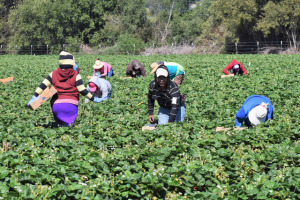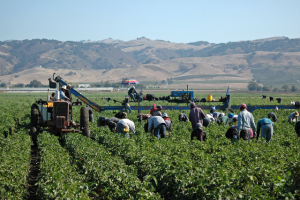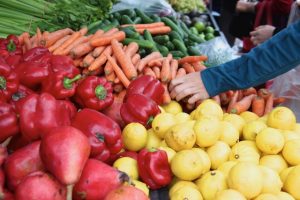Notes on the Network
May 15, 2008 Michael R. DimockAs you may have noticed, ROC is always talking about “the network” or the “Leadership Network.” That’s because it’s a central part of our theory and strategy about how to make change. The upcoming listening sessions that the State Board of Food and Agriculture is holding in May and July to set 30 goals for 2030 around the food system (see calendar) provides a wonderful medium for applying network power. And ROC will be encouraging the network in the next ten days to engage the State Board. Therefore, I thought it might be important to provide a more thorough explanation of the term “network” from my perspective. If we hope to effectively collaborate, coming to a common understanding about the words we use is essential. So here is what I think about the network.
Simply put, a network is a system of intersection points (nodes) and flow routes (links). Applied to human dynamics, a “social” network describes the relationship between the nodes (individuals and their organizations/businesses) and the links (common purpose, values, principles, information, goods, services, and activities). The network is free of overarching bureaucratic structures and this freedom increases effectiveness and accelerates progress. The network’s vitality is important in a time when rapid innovation is required.
Lots of people are talking about networks today. Networks have become important because people have come to understand the concept of the “network effect”, which says that the value of a network (its effectiveness) grows in proportion to the number of nodes and links. One person talking to five others in one year and implementing one small project has some effect. In contrast, 40,000 people each talking to 20 others in a year and together implementing 100 larger projects has, relatively speaking, a quantum effect.
We are currently seeing the emergence of powerful networks across all sectors of society. Unprecedented levels of education, wide access to information technology, the quantity and quality of information itself, and the diminishing influence of traditional social conventions, support the individual’s ability to join a network. Every person can form their own opinion, start their own project, and rally others to join them using email, websites, and cell phones. People also feel free to leave one network and join another at any time.
The network is powerful, but fluid participation requires certain forms of nurturing to keep it intact and thriving. The self-directed nature of modern people means that effective leadership does not emerge from coercion and control. Good network leaders are more like stewards, coaches or mentors who discover motivation, channel energy, and facilitate meaningful, collaborative action.
Through a network one can share values and beliefs that will aggregate a community of common interest, people motivated by visions or beliefs. Communication comes in different forms: person-to-person contact and mass media; visual and auditory; written and spoken; paper and electronic. All these forms are needed to communicate to people organizations, and businesses. New network members are often attracted by shared beliefs, and in joining they become more attuned to the information flowing in the network. Many who are more involved and enlivened by the information share will support the network’s activity – leading a node of activity in a specific space or place. That’s how the edge of the network continually grows. With each added activity node, more information flows, more opportunities to act, and more potential points of contact with the world emerge. Each person and organization in the network creates a sub-network and the overall interface with the world expands exponentially.
ROC’s evolution reflects this dynamic. Early on, the ROC Council launched the Vivid Picture and leadership development projects, sowing the seeds for the formation of a powerful new network. The purpose of creating a vision and building leadership defined the network and bound the nodes. Those sharing their visions through the Vivid Picture, acting in their local community through the AFA Roundtables, or participating at the state level through the California Roundtable on Agriculture and the Environment, joined the statewide network through their participation. The Council itself was the central node in the network, from which energy in the form of money and calls to action flowed. Each roundtable formed another node.
ROC has cultivated the growth of the network considerably since 2006. For instance, the staff became a node unto itself when it hired its first chief executive. ROC has continued to add nodes and people up and down the state in a wide variety of ways, including: reaching out in community meetings and online to share the New Mainstream vision, bringing leaders together in the Planning Fellows program, and inviting new people to participate in an increasing number of projects.
Just in the last five months important new nodes have joined the network: CDFA, the State Board of Food & Agriculture, TBL Capital, RSF Social Finance, SAGE, American Farmland Trust, the City of San Francisco Mayor’s Office, USDA, HHS, International Rescue Committee of San Diego, Economic Opportunities Commission of Fresno, and Slow Food Nation. Consequently, the potential power of the network has increased.
Still, the scale of change before us in order to reach the goal of a sustainable food system for CA by 2030 is huge. Therefore, the question remains: how can ROC maximize the network effect and accelerate transformation of the food system?
The answer lies in an additional concept related to network dynamics. Successful networks mimic nature by permitting a harmonious balance of chaos and order to optimize creative innovation or evolution. ROC must help the network find this balance between chaos and order. This means ROC must inspire leadership and support the nodes in governing and implementing action themselves. At the same time, ROC must determine how best to use its limited supply of money for grants and contracts.
This central challenge may be more art than science. It requires trust, faith and patience. It requires that stewards of the network and leaders of the nodes allow themselves to endure the tension of the opposites and to find the razor’s edge of balance. It requires that those involved allow their hearts and minds to work in harmony.
Clearly, no one person can effectively decide what is best for the whole food system. Many eyes, hearts and minds are needed to deal with the complex reality now faced. If, as network stewards, we work to create a functional atmosphere with good communication around purpose, objectives and opportunities to act, the network will thrive; it will sort through the complexity of our task. Network participants will find a healthy balance between chaos and order, and maximize creativity in the innovative actions on the ground. ROC used this approach to create the Campaign Strategy last fall and early winter and to write a grant proposal to USDA’s Risk Management Agency in March. Both rendered good products that help orient collaborators. We will continue to do the same as we invite network members to launch Workgroups in pursuit of objectives.
In the year ahead, ROC must seek deep integration between network objectives and the nodes of participation. We must nurture the network’s links with clear communication, good information, and meaningful opportunities to collaborate, but also empower the network by allowing the nodes to make manifest the common purpose, values, and principles in diverse ways up and down the State. By doing this well, ROC could become a unifying force serving the many faceted movement seeking a sustainable food system in California.



